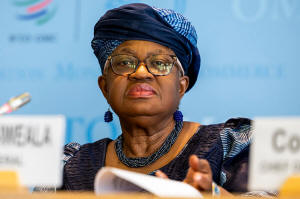|
The
Geneva-based trade body said Tuesday its economists are
increasing their prediction of growth in merchandise trade to
2.4% this year, up from 0.9% as recently as August. In April,
WTO experts were actually anticipating a decline of goods trade
this year of 0.2%
However, they're lowering the prediction for 2026 to 0.5%, from
1.8%.
The growth of export in services, meanwhile, is expected to come
in at 4.6% in 2025 and 4.4% next year — both slower rates than
the 6.8% tallied in 2024.
WTO pointed to “robust trade in artificial intelligence-related
goods" that are driving the increase in merchandise trade,
notably semiconductors, servers and telecommunications
equipment.
Director-General Ngozi Okonjo-Iweala suggested solid trade
growth among developing countries and a cool-headed reaction to
sweeping — and often-varying — tariffs announced by the Trump
administration earlier this year had underpinned the gains.
“Countries’ measured response to tariff changes in general, the
growth potential of AI, as well as increased trade among the
rest of the world — particularly among emerging economies —
helped ease trade setbacks in 2025,” she said.
Despite “strong headwinds," Okonjo-Iweala said trade has shown
resilience because of “importers front-loading orders to get
ahead of future tariff hikes or retaliation.” U.S. inventories
are at record levels by dollar value, and the value of North
America’s imports surged 13.2% at an annual rate, driven by
pharmaceuticals and precious metals — mostly gold.
She also attributed the gains to “soaring demand” for AI-related
products behind a capital investment boom. A staggering 42% of
global trade growth came from AI-related goods, she said, much
higher than their 15% share in world trade.
South-South trade — among developing countries — grew 8%
year-on-year in value terms in the first half of the year, while
such trade involving partners other than China is growing at
around 9%, WTO said.
All contents © copyright 2025 Associated Press. All rights reserved

|
|




